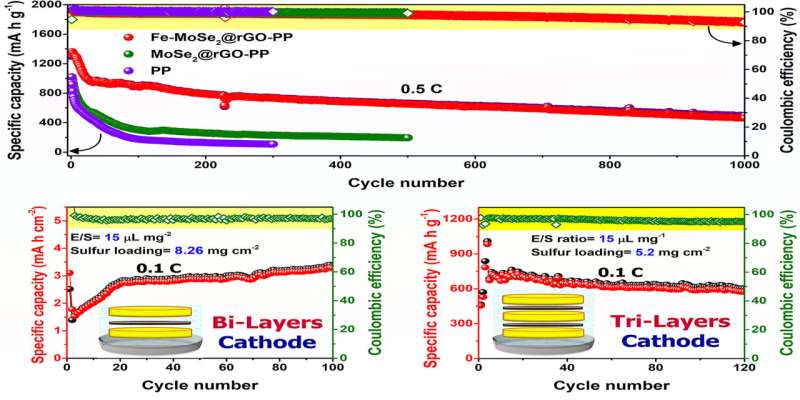Developing conductive and electrocatalytic mediators in Li-S batteries

Lithium sulfide (Li-S) batteries are considered a promising and efficient energy storage system because of their high energy density (2600 Wh kg-1) and low sulfur material cost. However, numerous obstacles to the practical implementation of Li–S batteries remain, including low sulfur conductivity, the shuttle effect, and the requirement for an adequate volume change (80%) of sulfur during charging and discharging operations. These have limited the applicability of Li–S batteries.
Transition metal chalcogenides (TMDs), such as molybdenum diselenide (MoSe2), have received attention as a viable method for accelerating sulfur redox processes. However, the limited number of active sites in MoSe2 considerably reduces their overall electrocatalytic performance.
Metal doping into MoSe2 can improve the electronic conductivity of MoSe2 and generate defects, creating numerous reactive sites for catalytic reactions. Moreover, polysulfide transformation in the Li–S system can be improved through defect engineering, which can alter the physicochemical and electronic structure to enhance the adsorption and catalytic properties of a material.
Recently, Yutao Dong and Jianmin Zhang (corresponding authors), Mohammed A. Al-Tahan (first author), and others published a manuscript titled “Modulating of MoSe2 functional plane via doping-defect engineering strategy for the development of conductive and electrocatalytic mediators in Li-S batteries” in the Journal of Energy Chemistry.
The authors demonstrate that introducing iron exposes more active selenium edge sites in MoSe2, which can selectively adsorb more lithium polysulfides (LiPSs) to minimize the shuttle effect. Moreover, the conductive feature of rGO improves the cell’s electrical conductivity and promotes the adsorption of polysulfides via chemical bonding with the functional group of rGO. Therefore, using the Fe-MoSe2@rGO nanohybrid as a functional plane offers the advantages of high conductivity and effective LiPS adsorption.
Organic porous structures on 2-D defect networks
Mohammed A. Al-Tahan et al, Modulating of MoSe2 functional plane via doping-defect engineering strategy for the development of conductive and electrocatalytic mediators in Li-S batteries, Journal of Energy Chemistry (2022). DOI: 10.1016/j.jechem.2022.09.001
Citation:
Developing conductive and electrocatalytic mediators in Li-S batteries (2022, September 23)
retrieved 24 September 2022
from https://phys.org/news/2022-09-electrocatalytic-li-s-batteries.html
This document is subject to copyright. Apart from any fair dealing for the purpose of private study or research, no
part may be reproduced without the written permission. The content is provided for information purposes only.
For all the latest Science News Click Here
For the latest news and updates, follow us on Google News.

